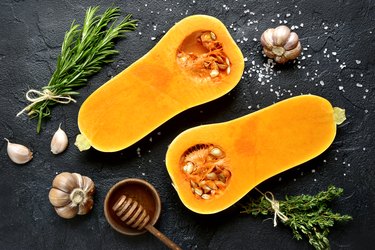
Butternut squash, a nutritious winter squash marked by its distinctive pear-like shape and pale gold skin, is easily incorporated into many seasonal recipes.
For example, butternut squash pasta, risotto, ravioli, hummus, a velvety puree or soup with butternut squash chunks — the options are endless.
Video of the Day
Video of the Day
Like most winter squash, butternut squash is rich in carotenoids: beta carotene (a precursor to vitamin A), lutein, zeaxanthin, protein, vitamin C and B6, fiber, magnesium and potassium, Harvard University's School of Public Health's Nutrition Source notes.
Tip
Butternut squash goes with sweet — think cinnamon, ginger and nutmeg; or savory, think thyme, sage and oregano — flavors and may be used in a variety of dishes. Technically a fruit, this hard-skinned winter squash turns up in ravioli, soups and even pie.
Butternut Squash Health Benefits
Harvard details some of the specific health benefits of winter squash as being helpful in warding off diabetes and cancer, as well as being beneficial in supporting heart health. Squash is a filling food that is low in calories — 45 to 90 calories per cup cooked, depending on type. Butternut squash in particular was singled out as having almost half the amount of carbohydrates of a sweet potato and having a low glycemic index and load.
In addition, the compounds beta carotene and lutein are classified as flavonoids and may help to protect human cells from the damaging effects of oxygen. Squash's high level of potassium — about 500 mg per 1 cup of cooked butternut or acorn squash — can help to counteract the deleterious effects of sodium on blood pressure, according to Harvard.
Butternut squash, like all winter squash, is a member of the Cucurbitaceae (gourd) family. It is technically classified as a fruit but in cooking is treated like a vegetable, reports the Library of Congress.
How to Prepare Butternut Squash
Butternut squash differs from summer squash in that it is harvested and eaten in the mature fruit stage — meaning that its seeds have fully matured and the skin has become hardened into a tough rind. When it has ripened to this stage, squash can be stored for use throughout the winter, according to the University of Illinois Extension.
To prepare butternut squash for cooking, start by choosing a squash that is mostly unblemished and feels heavy in your hand (a few scratches on the skin are normal). If you plan to cut up the squash, peel away the tough outer skin, halve it and remove the seeds and fibrous material inside. Then cut up the squash into chunks.
If you plan to roast your butternut squash with the skin on, simply halve the squash and remove the seeds and inner fibrous material from the cavity before you continue on with your recipe.
Cooking with Butternut Squash
Butternut squash goes with almost everything and may be used in many recipes and with various herbs. Thyme and sage are savory favorites. Cinnamon, ginger and nutmeg along with maple syrup or honey make for a sweet result when they are added to butternut squash before it's baked in the oven.
Butternut squash puree works well folded into ricotta cheese to make a ravioli filling with sage. Or try making a creamy risotto with butternut squash and Parmesan cheese and lemon. It also can be turned into a nutritious pasta sauce. You could use butternut puree in place of mashed potatoes or in a casserole for a lower-carb dinner option. Butternut squash can also be easily used in place of pumpkin in pies.
It might be difficult to claim one recipe as being the best butternut squash soup recipe, but you could make a simple, smooth pureed soup with garlic, onion, apples or pears and butternut squash. After preparing one squash for cooking, sauté the garlic and onion in 1 tablespoon olive oil in a large soup pot over low heat until softened. Add two peeled, cored and diced apples (or pears) along with the squash and 6 cups of vegetable or chicken stock. Bring to a boil then reduce to a simmer until vegetables are softened. Puree in a blender until smooth.
Read more: Nutritional Content of Pears vs. Apples
You could also make soup with butternut squash chunks; omit the apples and puree half the soup in a blender, reserving the other half to stir in afterward. Serve with toasted whole wheat bread and a salad for a complete meal. If you are looking for more protein to eat with butternut squash soup, roasted meat is a natural accompaniment.